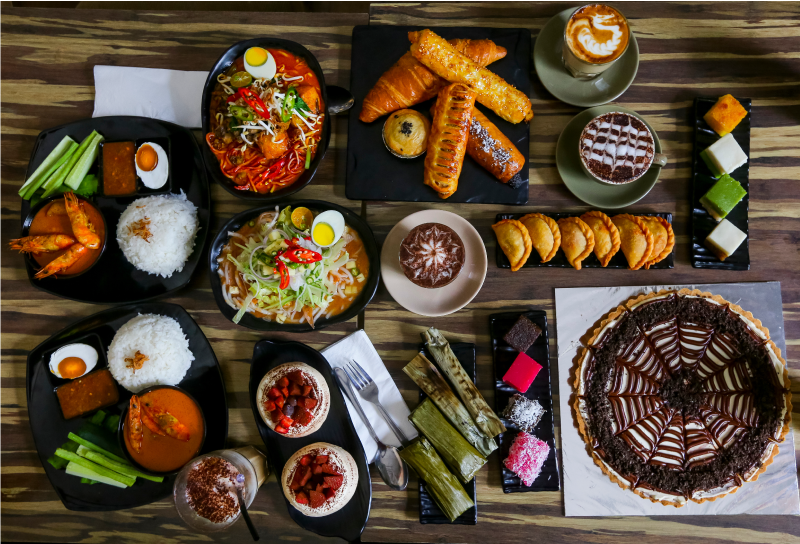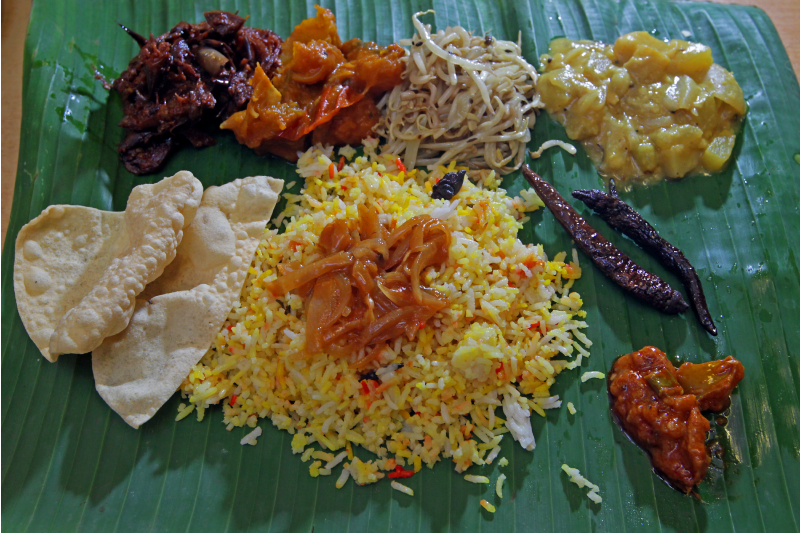
Malaysia is a multicultural country and offers infinite varieties of different cuisines. It’s a gastronomic adventure for foodies and tourists alike from Indian curries to Malay desserts, savoury and spicy Peranakan and Eurasian food to the eclectic repertoire of Chinese dishes from the many provinces of China.
The gastronomic adventure begins with the tantalizing of taste buds, the ignition of imagination and a happy stomach. Let’s take a look at some of the dishes from each race.
Malay
One Malay food that is loved by all Malaysians is nasi lemak. Nasi lemak consist of rice cooked in coconut milk and pandan leaves. Basic nasi lemak will contain sambal, ikan bilis (dried anchovies), boiled eggs and cucumber. Chicken or beef rendang, fried chicken or other seafood sambal can be added to complement the dish.
Another popular food is satay, which is chunks of chicken, beef or lamb that’s skewered on a stick and then grilled over a charcoal stove. It is served with a spicy peanut sauce and condiments like ketupat, raw onion wedges and cucumber.
Chinese
Bak Kut Teh in the Hokkien or Fujian dialect literally translates to “Meat Rib Tea”. This dish is a rich herbal soup that is known for its warming properties. Traditionally cooked in a clay pot, it is a hearty meal made with ribs, dried Shitake mushrooms, tofu puffs and garlic. The dish is then served with plain or yam rice accompanied with yau char kuai (Chinese crullers) and stir-fried vegetables.
Hainanese chicken rice hails from the tropical island of Hainan, China. A plate of Hainanese chicken rice may just look plain and simple but the key to this delicious meal is the fragrant rice and perfectly moist and silky steamed chicken that is doused in light soy sauce and topped with spring onion and coriander. 3 sauces – a chilli sauce, ginger sauce and sweet dark soy sauce are served together and heightens the dish to a whole new level.
Indian

Indian food plays a major part in the diverse spectrum of the food in Malaysia, and banana leaf, as it’s commonly known, is a local favorite. An experience for those who have not tried it. You sit at the table and a banana leaf is used to replace a plate. A waiter will then dish up the rice together with various curries. No utensils are needed when you eat. Just dig in with your fingers and enjoy!
Murtabak; similar to a stuffed omelette pancake is an Indian Muslim cuisine that can be eaten all day long. The pancake is stuffed with minced meat, onions and spices and pan-fried until golden brown. It is then eaten with curry and pickled onions.
Peranakan

Peranakan cuisine is known for their delicious fusion food. These Nyonya dishes are the perfect marriage between Southeast Asian spices and oriental seasoning, using local produce as a base. One authentic dish that you must try is Pai Tee, an appetizer made of little cups of crispy fried pastry and then filled with braised jicama, beansprouts, julienne cucumber and sliced eggs. Top it with chilli sauce and coriander and enjoy.
Ayam buah keluak is another dish to try. The main ingredient is buah keluak and the spicy tamarind gravy that is made from a blend of spices. Ayam buah keluak is usually served with rice and diners will eat the rice with gravy as well as the mixture in the buah keluak.
Eurasian
Singgang Serani, a Eurasian fish curry contains the delicate flesh of deboned fish which is infused with creamy rich flavours enhanced by spices. The flavours of singgang are almost similar to that of the Peranakan dish “otak-otak” save for a slightly different use of herbs and spices.
Another sought after dish that is made popular by the Portuguese Eurasians is Devil Curry. This authentic chicken curry is flavoured with vinegar and other spices like red chillies, lemongrass, galangal and turmeric to give it its sharp tangy taste.
